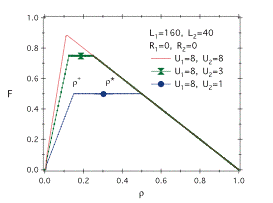Phase Structure of Segment Dependent NCS Model 1
although it is now clear that the intermediate region in the fundamental diagram between free traffic phase and the jamming phase reflects the existence of new type of congestio in Nishimura model, the new region does not really constitute a phase as such, because the with of that region is L-dependent, and it disappears altogether in L \to \infty limit.
One more twist is required to make it a bona fide phase that survises the large L limit. We now show in the following several pages that the key to that quest is in the breaking of spatial uniformity.
Let us imagine that the road is devided into S segments each containing L1、L2、... 、LS cells, and allow the traffic parameters to vary from segment to segment. Li must of course add up to the total length of the road L:
|
L = L1 + L2 + ... + LS
|
(6.1)
|
At the k-th segment with length Lk , we set the speed limit to be Uk and the non-acceleration rate Rk.
In real-life traffic, even for a highway without a single traffic light, there are curved segments in which drivers tend to slow down more frequently. Downward inclination effectively brings up the speed limit and upward inclination down. So the assumption of uniform road with single set of parameters is in fact less ralistic than a road with segment-dependent variable parameters.
We first look at the simplest example of two segments whose lengths are given by L1 and L2 , the speed limits by U1 、U2 , and non-acceleration rates R1 、R2 . We start with the case of a common non-acceleration rate R1 = R2 = 0.
| The fundamental diagram of one such example is shown in the right. Here a road with L = 200 cells are devided into a segment with L1 = 160 cells and another segment with L2 = 40 cells. We superimpose three cases of segment velocities, U1 = U2 = 8, U1 = 8, U2 = 3 and of U1 = 8, U2 = 1. The third phase is clearly observed as the flat plateau with flux F=(U2+1) in between the free and jammed phases. This corresponds to the formation of jammed block at the low speed segment that extends to the high speed segment. |
|
|
